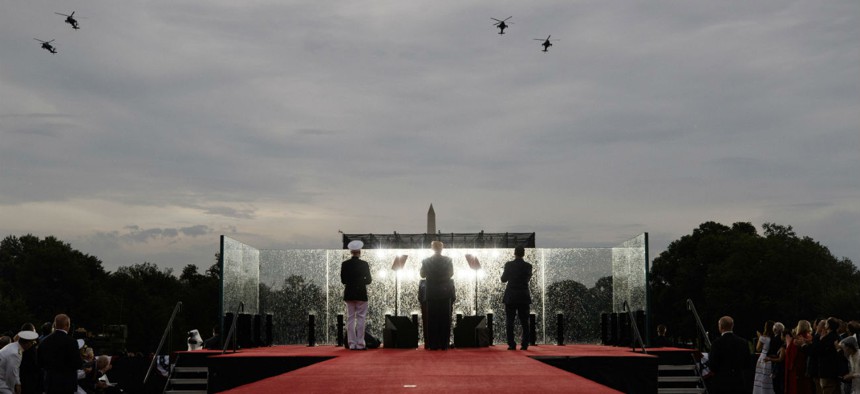Pentagon Puts Price Tag of July 4 Pageantry at $1.2 Million
Most of the money for flyovers and tank displays came from training budgets.
The President Trump-directed “Salute to America” pageant at the Lincoln Memorial on July 4 cost the Defense Department $1.2 million, its comptroller’s office said on Tuesday.
The event attended by members of the Joint Chiefs and featuring flyovers, ceremonial units and heavy tanks transported to the nation’s capital became controversial among Democratic lawmakers and advocacy groups that considered it wasteful and inappropriate. The White House-produced festivities also reportedly required re-purposing $2.5 million from the National Park Service’s budget.
In advance of expected scrutiny from congressional panels, the Defense Undersecretary’s Office—after consulting with the individual services—said in a statement to Government Executive that “funding for the demonstrations came from the military services' training budgets that facilitate flying hours, which are imperative to military readiness.” Additional funding was used for the transportation of static displays and equipment, for a total of $1.2 million, the statement said.
“The Department of Defense has a long history of showcasing military assets to the country in order to recognize our military's contributions to the safety and security of the nation, and to assist in recruiting future generations of service members,” the statement added.
The comptroller’s inventory of the aircraft and ground equipment deployed for the July 4 ceremony included:
- Four AH-64E Apache Guardian helicopters from the 101st Combat Aviation Brigade in Fort Campbell, Ky.;
- Two MV-22 Ospreys aircraft and one VH-92 helicopter (often called the “new Marine One”) from Marine Helicopter Squadron One from Marine Corps Base Quantico, Va.;
- Two F-35C Lightning II aircraft from Strike Fighter Squadron 147 from the Naval Air Station in Lemoore, Calif.;
- Two F/A-18 Hornet aircraft from Strike Fighter Squadron 37 from the Naval Air Station in Oceana, Va.;
- Six F/A-18 Hornet aircraft from the Navy Flight Demonstration Squadron (Blue Angels) from the Naval Air Station in Pensacola, Fla.;
- One VC-25 aircraft (known as Air Force One) from the Presidential Airlift Group from Joint Base Andrews in suburban Maryland;
- One B-2 Spirit aircraft from the 509th Bomb Wing from Whiteman Air Force Base in Missouri;
- Two F-22 Raptor aircraft from the 1st Fighter Wing from Joint Base Langley-Eustis in Virginia;
- One MH-60J/T Jayhawk helicopter, one MH-65 Dolphin helicopter and one HC-144 Ocean Sentry aircraft from the Coast Guard Atlantic Sector at the Coast Guard Station in Annapolis, Md.; and,
- Two M1A2 Abrams Main Battle Tanks and two M2 Bradley Fighting Vehicles from the 3rd Infantry Division, Fort Stewart, Ga.
The ceremonial units included:
- The U.S. Guard Fife and Drum Corps, 3rd U.S. Infantry Regiment (The Old Guard) from Joint Base Myer-Henderson Hall in Northern Virginia;
- The U.S. Marine Corps Silent Drill Platoon from the Marine Barracks in Washington, D.C.; and,
- “Free Country,” the U.S. Marine Corps Band from the Marine Barracks in Washington, D.C.
The Pentagon supplied yearly numbers for similar flyovers done regularly by the services for training purposes. The Army, for example, in 2018 conducted 44 flyovers, the Marines 22, and the Air Force 660 flyovers, including 130 static, aerial demonstrations and flyovers to support air shows.
Costs of those past training exercises were reported at $35 million for flights by Air Force Thunderbirds. For the Navy during regional fleet weeks from 2017 to 2019, the costs came in at $1.8 million for San Francisco Fleet Week; $1.6 million for Los Angeles Fleet Week; $1.3 million for New York’s Fleet Week ($2.5 million if fuel is counted); $1 million for the Seattle Fleet Week; and $1 million for the Portland Fleet Week.
For the Navy’s Blue Angels, the total cost of 47 flyovers during that period was $36 million.




